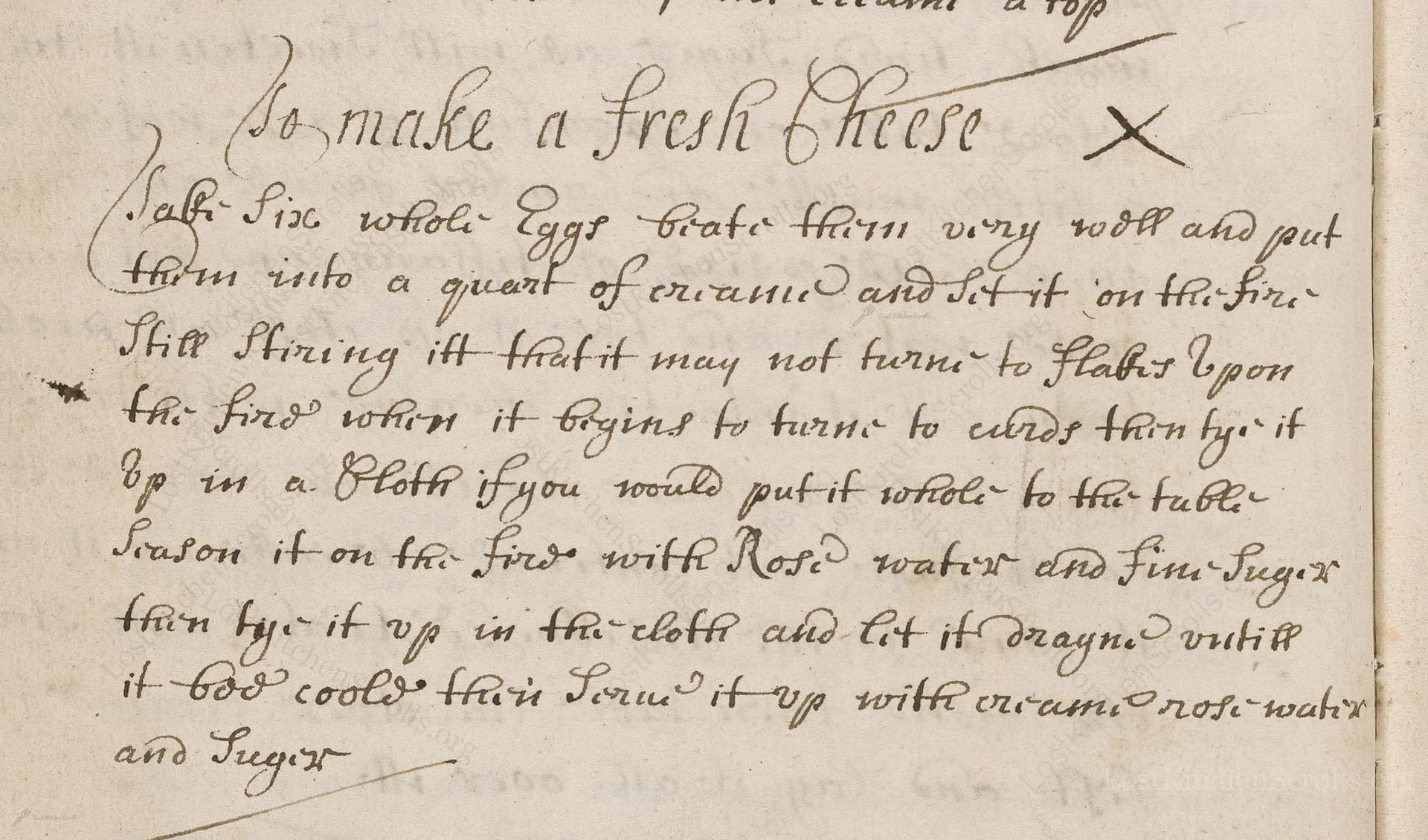To Make A Fresh Cheese
From the treasured pages of Cookery book of Ann Goodenough
Written by Ann Goodenough

To Make A Fresh Cheese
"Take Six whole Eggs beate them very well and put them into a quart of creame and Set it on the fire Still Stiring it that it may not turne to flakes Upon the fire when it begins to turne to curds then tye it up in a Cloth if you would put it whole to the table Season it on the fire with Rose water and fine Sugar then tye it up in the cloth and Let it drayne untill it bee cold then Serve it up with creame Rose water and Sugar."
Note on the Original Text
The recipe employs a conversational, run-on style common in early modern English cookery books, giving broad instructions without precise timing or temperatures. Spelling is archaic but understandable: 'creame' for cream, and 'tye it up in a cloth' instead of 'tie'. Measurements are also approximate—'a quart' being about 1 liter. The recipe assumes the cook has experience with curdling and draining dairy, and it blurs the lines between what we now think of as cheese, custard, and dessert.

Title
Cookery book of Ann Goodenough (1738)
You can also click the book image above to peruse the original tome
Writer
Ann Goodenough
Era
1738
Publisher
Unknown
Background
A delightful journey into the kitchens of early 18th-century England, this collection captures the flair and flavors of its time with recipes crafted by the inventive Ann Goodenough. Expect a charming medley of hearty roasts, comforting pies, and time-honored confections, perfect for those wishing to dine as they did in Georgian days.
Kindly made available by
Folger Shakespeare Library
This recipe hails from the early-to-mid 18th century, a time in England when the domestic kitchen was alive with inventive approaches to dairy and desserts. Ann Goodenough, active between 1700 and 1775, likely provided this recipe as a genteel, impressive dish for special occasions or guests. Cream, eggs, sugar, and rose water were luxury ingredients symbolizing refinement, and such a ‘fresh cheese’ would be a soft, sweet, unaged delicacy quite different from today’s typical cheeses. This dish sits somewhere between a set custard and what we might now call ricotta or paneer, showing the playful side of historical English cookery.

Traditionally, cooks would have used a heavy iron saucepan or a copper preserving pan over an open hearth or range fire. Constant stirring would be done with a sturdy wooden spoon. Cheesecloth, linen, or muslin would be used to tie and drain the curds, and a colander or wooden draining board might support the draining. Serving would require a shallow dish or plate for presentation.
Prep Time
10 mins
Cook Time
20 mins
Servings
8
We've done our best to adapt this historical recipe for modern kitchens, but some details may still need refinement. We warmly welcome feedback from fellow cooks and culinary historians — your insights support the entire community!
Ingredients
- 6 whole eggs
- 1 quart heavy cream (minimum 35% fat)
- 1 tablespoon rose water (culinary-quality)
- 2 tablespoons fine white sugar
- Extra: more cream, rose water, and sugar for serving
Instructions
- To recreate this fresh cheese in a modern kitchen, start by whisking together 6 whole eggs with 1 quart of heavy cream (minimum 35% fat).
- Pour this mixture into a saucepan and set it over gentle, medium-low heat.
- Stir constanly and slowly, ensuring the mixture heats evenly without scorching or forming lumps.
- As it nears a simmer, you’ll notice curds starting to form.
- When you begin to see clear separation but before large clumps form, season gently with about 1 tablespoon of rose water and 2 tablespoons of fine sugar, stirring to dissolv.
- Once curds are visible and the mixture thickens, pour into a large piece of clean muslin or cheesecloth set over a colander.
- Tie up the corners to make a pouch and let the cheese drain until cold and firm—about 1-2 hours.
- Unwrap, turn out onto a plate, and serve with a drizzle of fresh cream, some more rose water, and a generous dusting of sugar.
Estimated Calories
600 per serving
Cooking Estimates
You will spend a few minutes preparing your ingredients, about 20 minutes cooking gently on the stove while stirring, and around an hour waiting for the cheese to drain and firm up. Each serving is rich, since it's mostly cream and eggs.
As noted above, we have made our best effort to translate and adapt this historical recipe for modern kitchens, taking into account ingredients nowadays, cooking techniques, measurements, and so on. However, historical recipes often contain assumptions that require interpretation.
We'd love for anyone to help improve these adaptations. Community contributions are highly welcome. If you have suggestions, corrections, or cooking tips based on your experience with this recipe, please share them below.
Join the Discussion
Rate This Recipe
Dietary Preference
Main Ingredients
Culinary Technique
Occasions

Den Bockfisch In Einer Fleisch Suppen Zu Kochen
This recipe hails from a German manuscript cookbook compiled in 1696, a time whe...

Die Grieß Nudlen Zumachen
This recipe comes from a rather mysterious manuscript cookbook, penned anonymous...

Ein Boudain
This recipe comes from an anonymous German-language manuscript cookbook from 169...

Ein Gesaltzen Citroni
This recipe, dating from 1696, comes from an extensive anonymous German cookbook...
Browse our complete collection of time-honored recipes



